Cactus Care Guide: Watering, Sunlight, Soil and More

Indoor cactus plants are types of succulents that are very easy to look after. Cacti belong to the plant family Cactaceae. These succulent plants have thick fleshy leaves or stems that retain plenty of moisture. Cacti need less watering than other houseplants due to their thick succulent stems. There are about 1,750 species of cacti—some look like round furry balls with spikes whereas others are tall with stems that reach upward.
How to care for cacti: Grow cactus plants in fast-draining soil and water when the potting mix dries out. Cacti thrive in bright sunlight up to 12 hours a day. In summer, cactus plants may need watering every week but in winter, every four to six weeks. Cacti grow in temperatures between 65°F and 80°F (18°C – 27°), low humidity, and need feeding twice or three times in the growing season.
Cacti are super hardy indoor houseplants that survive in most conditions. If you care for a cactus well, it can thrive indoors for many decades. Some species of outdoor cacti can live between 20 and 200 years. To help cacti live long, the plants need thorough watering as often as the soil becomes dry.
Cacti—like most succulents—are slow-growing plants, especially when growing in pots indoors. Over the first two or three years, cactus plants only grow a few centimeters. When growing in optimal conditions and if they get enough water, the plants usually grow between 0.5” and 1” (1 – 3 cm) a year. Due to their slow growth rate, cacti don’t need much feeding.
In this article, you will find a complete guide to caring for a cactus indoors. First of all, let’s find out more about indoor succulents.
About Cactus Plants

Succulent cacti can grow indoors as houseplants or outdoors as drought-resistant plants
Cacti are flowering plants that are characterized by thick, fleshy stems. Cactus plants are usually divided into two groups—desert cacti and forest cacti.
Desert cacti are drought-resistant plants that can survive for weeks without any water. These types of cacti generally need bright light to thrive. Most desert cacti are characterized by sharp spines and ribbed stems. The stems can be tall and long or short and globular.
Forest cactus plants are epiphytes, which means they absorb moisture through aerial roots and leaves. Cactus that are native to rainforests can survive in low light. However, they prefer bright, indirect light to grow well.
Compared to other houseplants, cacti and succulents have minimal moisture requirements. If you provide them with plenty of water when the potting mix becomes dry and then let the water drain out, your cactus will grow for years.
How Often to Water a Cactus
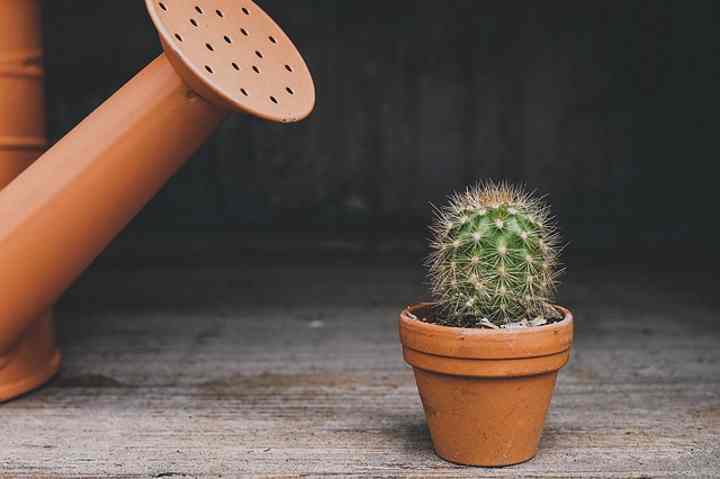
Water your cactus when the soil is completely dry rather than watering it on a set schedule
It’s time to water a cactus when the potting mix becomes completely dry. You can press the soil to check for any moisture. If there is no sign of moisture in the potting medium, then it’s time to water it. In hot summers, a cactus may need watering once a week. In winter, possibly once a month.
Knowing how often to water cacti is key to their healthy growth. A large, well-established cactus in a big pot won’t need watering as often a small cactus. In fact, a little or mini cactus may need watering more frequently than larger ones. Of course, the amount of water depends on the size of pot, type of cactus, and type of potting mix.
Remember—only water a cactus as much as it needs. This means waiting until the soil is arid and then thoroughly watering the plant until water drains out the bottom.
When deciding when to water your cactus, err on the side of caution and don’t water it too often. Of course, cacti are famous for surviving many weeks of drought. But an indoor house cactus won’t thrive on neglect. So how can you know when you’re under-watering or over-watering your succulent plants?
Signs that a cactus needs water include stems that appear weak, shriveled, or puckered. Lack of moisture forces the plant to use up its stores to survive. An underwatered cactus will also look pale and may even start to turn brown. Of course, these signs will be accompanied by bone-dry soil.
Signs that you are overwatering your cactus are usually that the stems or leaves become brown, black, and mushy. An overwatered cactus also appears swollen and overly-fat because the plant absorbs too much moisture. If you remove the plant from the soil, you will notice that roots will have started to decay in the wet soil.
Reviving an underwatered cactus plant is far easier than one that’s been watered too often. If your cactus has been surviving in drought-like conditions, saturating the soil with plenty of water should do the trick. However, if weak growth and soft leaves are due to waterlogged soil, your cactus is in trouble.
Later in the article, you will find out how to bring back to life an overwatered cactus.
How to Water a Cactus
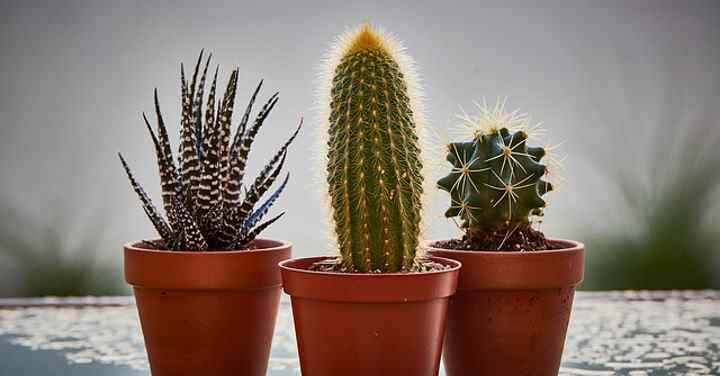
Soak your cactus with water when the plant soil is dry. Allow the water to drain and do not let the cactus sit in a dish of water
The ideal way to water a cactus is to drench the dry potting soil in plenty of water. It doesn’t matter what size the cactus is—large, small, or mini—the principle is the same. Wait until the soil is dry. Then pour in enough water until it drains out the pot. Wait until the soil is dry again before the next deep watering.
Rather than watering cacti often and a little, it’s best to water occasionally and thoroughly. Deep watering less frequently ensures roots get enough moisture and nourishment.
You can also water cactus from the bottom if you are careful. The advantage of providing moisture from the bottom is that it nourishes the roots better. Bottom watering also helps prevent soil mold and fungus gnats—problems that tend to affect the top part of the soil.
To water cactus from the bottom, wait until the soil is completely dry. Place in a saucer and pour about 0.5” (1 cm) of water into the dish. Wait until the cactus “drinks” the liquid. Add some more water. Repeat the process until the succulent stops absorbing. Remove from the saucer and place it on a dry drip tray.
Watering from the bottom is excellent for caring for globular spiky cacti where it’s difficult to water from the top. As you gain experience, you could learn to water a few cacti at the same time with this method.
A word of warning: Don’t make the mistake of filling a tray of water and letting a cactus sit in it for many hours. Watering from the bottom this way puts the cactus houseplant at risk of root rot.
How to Transplant a Cactus
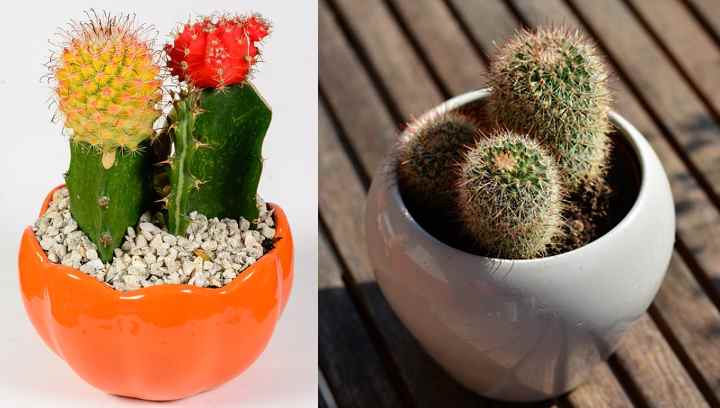
Transplant your cactus when the crown reaches the pot edge or when it becomes rootbound every few years
Cactus plants grow slowly and only need repotting every three or four years. The purpose of transplanting the plant to a new pot is to give roots space to grow. Cactus grows better in smaller containers and can become rootbound every few years.
You can tell when a cactus needs repotting because you’ll see roots poking out the drainage holes. You may also notice that water takes a long time to drain out the pot because the dense roots create a thick, dense medium. If you have ball-shaped cactus, it needs repotting when the crown reaches the pot edge.
Transplanting is also a great way of making a small cactus garden in a large container.
To repot a cactus, you’ll need a container larger than its current one, protective gloves, and sterile instruments. Fill the new container with cactus potting soil up to halfway. With a clean trowel, carefully dig out the cactus from its current pot. If the plant is especially spiky, use protective gloves. Put the cactus in the new pot, so it’s a few inches below the rim. Fill the remaining space with fresh potting soil.
An important piece of advice to remember when transferring a cactus: Don’t water it for a couple of weeks. Allow the plant to settle in and then give it a thorough watering when the potting mix had dried out.
How to Take Care of a Cactus
What else do you have to do to help a cactus thrive at home? Apart from watering your plant properly, you need to know about its light requirements, type of potting mix, and how to feed it.
Cactus Light Requirements
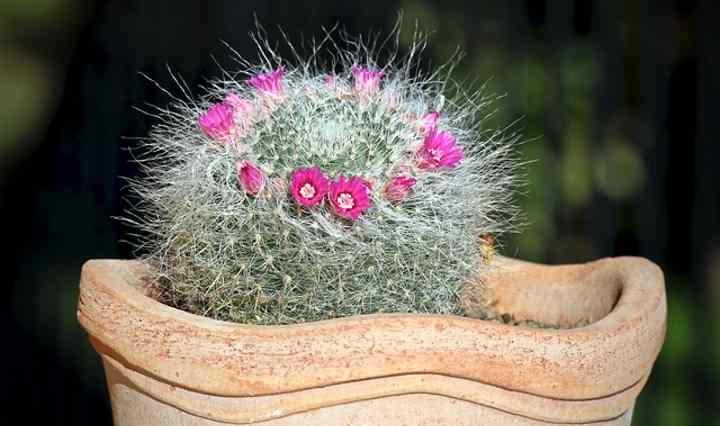
To care properly for your indoor cactus, make sure it gets plenty of bright light
Most cacti need plenty of bright light—in fact, 12 hours of sunshine daily is ideal. An ideal location for any kind of desert cactus is a south-facing windowsill. Some types of cacti can grow well in lower light conditions. So, if you can’t get enough sunlight, choose an appropriate species of cacti.
It’s important to remember that hot summer sun beating through a window all day can be very intense—even for a cactus. Apart from drying out the soil very quickly, the sun could scorch the succulent stems. If the plant starts to yellow, move it out of direct sunlight so that it gets some partial shade.
In the hot summer sun, remember to check every other day if your plant needs watering. Heat and lots of sunlight also cause more evaporation from the succulent plant. So, to avoid signs of underwatering, water more frequently during summertime.
Best Potting Soil for Cacti
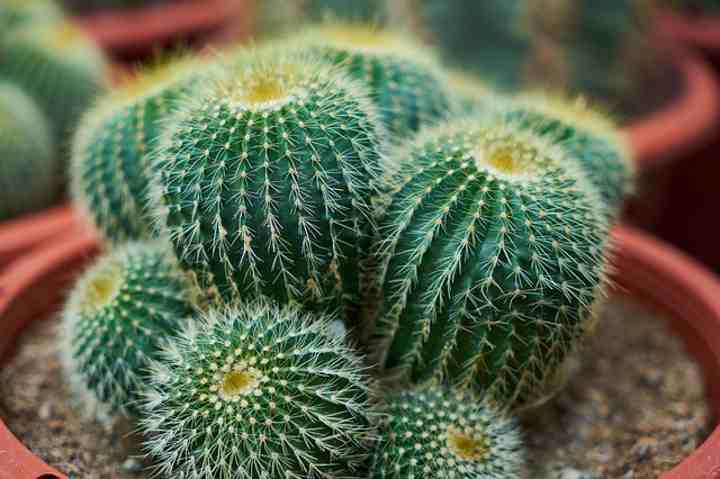
Good soil drainage is extremely important for your indoor cactus to grow well
Cactus plants grow well in light, aerated soil that has good drainage. The best cactus soil mix will hold just enough moisture to nourish the plant—but not too much that it suffers. Ideally, you need a type of potting soil mix that dries out quickly after watering.
Cacti quickly absorb the moisture they need from the soil. So, any leftover moisture will start to cause dampness problems and lead to mold, fungal disease, or rot.
Most garden centers sell appropriate types of cactus mix. Or, you can make a suitable potting medium for succulents and cactus. You can make your own excellent cactus mix by mixing five parts potting soil, two parts pumice stones, and one-part coconut coir. This type of cactus mixture should provide the ideal environment to create suitable soil for succulents that drains well.
Cactus Care: The Right Humidity for Cactus

Most cacti thrive in low humidity levels
Cactus plants love dry environments where there is low humidity. Because household air tends to be drier than outdoors, growing cactus plants indoors is super easy. Cacti need humidity levels around 20 or 30 percent to thrive. So, you should never mist cactus stems. Just water them regularly to keep moisture levels just right.
Some types of cactus grow well in high humidity. For example, the Christmas cactus is a flowering cactus that thrives in shaded places and warm, humid environments. So, if you’ve got a bathroom with a window, a Christmas cactus could be the ideal shower plant.
How to Propagate Cactus Plants

Bunny ears cactus can be easily propagated from offshoots
Cacti and succulents are some of the easiest plants to propagate. Some cactus plants produce offshoots that you can slice off and place in a small pot to grow a mini cactus. Other types of cacti are easily propagated by stem cuttings. Grafting is another propagation method to create unique houseplants.
How to propagate cactus from offshoots: Some cacti have new growths growing on the stems. Carefully remove the small mini cactus, place in a suitable container with the cactus mix, and it should start growing slowly. For example, bunny ears cactus are a type of cactus that is easy to propagate from offshoots.
How to propagate cactus from cuttings: Cut a stem from an existing cactus plant. Allow the stem to dry for five days on a paper towel. You may notice that small roots start to appear. Plant the stem cuttings in a small container filled with a moist cactus mix.
Grafted cacti—You can create a moon cactus by grafting one cactus on top of another one.
How Often Should You Fertilize a Cactus Plant
Cactus plants are slow growers and don’t require a lot of feeding. However, they benefit from diluted houseplant fertilizer to grow healthily. A half-strength, balanced fertilizer should help your cacti grow well and even flower under the right conditions. You should fertilize a cactus two or three times in the growing season.
In late fall and winter, don’t fertilize cactus or succulents. The only care that cacti need in winter is occasional watering—and only when the soil is completely dry.
Disease and Pests that Affect Cactus Plants
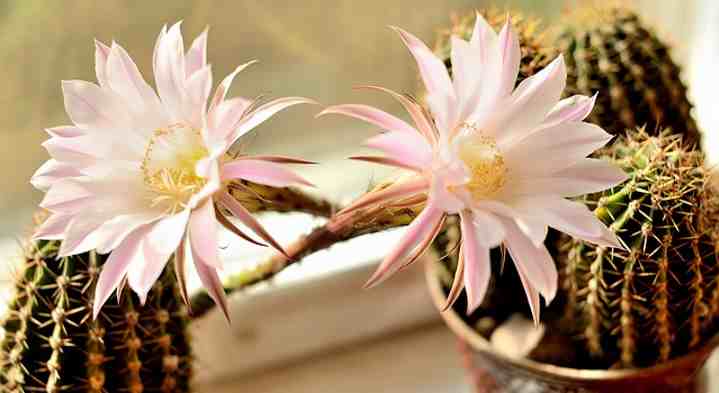
Caring properly for your succulent cactus will help prevent diseases and pests
Like with any indoor houseplant, fungal and bacterial diseases can affect cacti. Also, pests such as scale, spider mites, and mealybugs can infest cacti plants. Usually, proper care helps prevent most problems with cactus growth. However, sometimes you can get problems.
To prevent diseases affecting house cactus, there are three essential things to remember. You can keep your cactus alive for many years by following this advice:
- Grow cactus plants in well-draining soil
- Water only when the potting medium is completely dry
- Place in a bright sunny location
But, what can you do if you notice pests on your cactus? Here are a few ways to identify houseplant bugs and get rid of them:
- Scale–Scale on cactus plants looks like tiny dome-shaped shells. Scrape them off to prevent any plant damage. Rubbing alcohol also kills these pests on contact.
- Mealybugs—These pests look like bits of white cotton fluff on veins or spines. Use a natural neem oil solution to get rid of these common houseplant pests.
- Fungus gnats—Tiny black flies that live in the cactus soil are usually seen hovering around the cactus. They may not do much damage, but fungus gnats are annoying creatures.
- Spider mites—The first signs of these pests are web-like structures on the cactus stems. On closer inspection, you may notice tiny brown dots, which are the spiders.
Caring for Cactus in Winter
Cactus plants love hot, sunny environments. But caring for them in winter isn’t difficult. Cactus enter dormancy in the winter months and hardly need any care. You should make sure that the cacti get about three to four hours of light. Watering must be kept to a minimum, and only water them when you’re sure the soil is completely dry.
FAQs on Caring for Cactus Plants Indoors
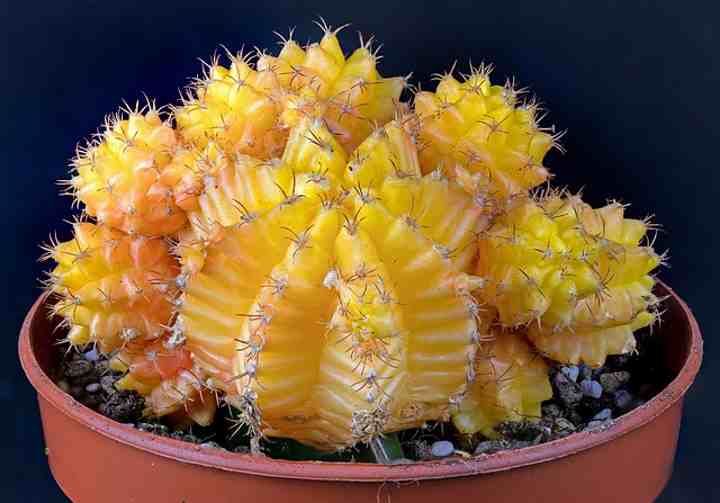
Although cactus are easy houseplants to care for, you may still have some questions. Here are answers to some common questions about cactus care.
Will my cactus flower?
Once cactus plants have been established for about two to three years, they should start to flower. To flower indoors, cactus need plenty of sun and nutrients during the growing season. Then in winter, they will bloom in cooler temperatures if there is enough light.
Why is my cactus growing tall and spindly?
Lack of sunlight is usually the reason for cacti to start growing spindly. Move the potted plant to a brighter location to improve growth.
Are cacti good terrarium plants?
Cactus are not good plants for closed terrariums because they don’t like humidity and need plenty of airflow to thrive. You can plant mini cacti and succulents together in an open terracotta pot with sandy soil. This way, you can create an attractive cacti garden.
Related articles:
